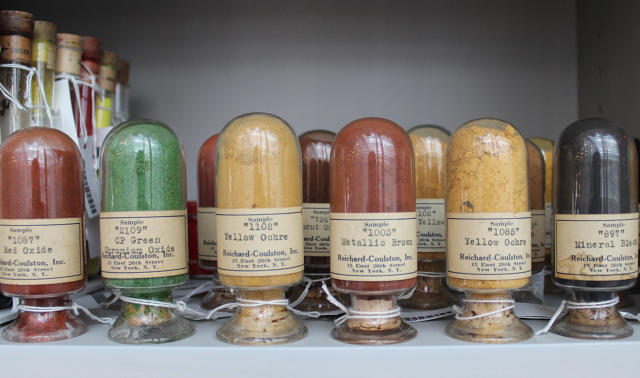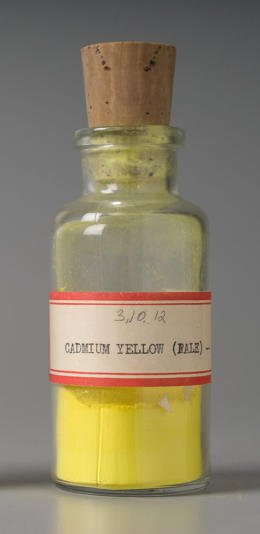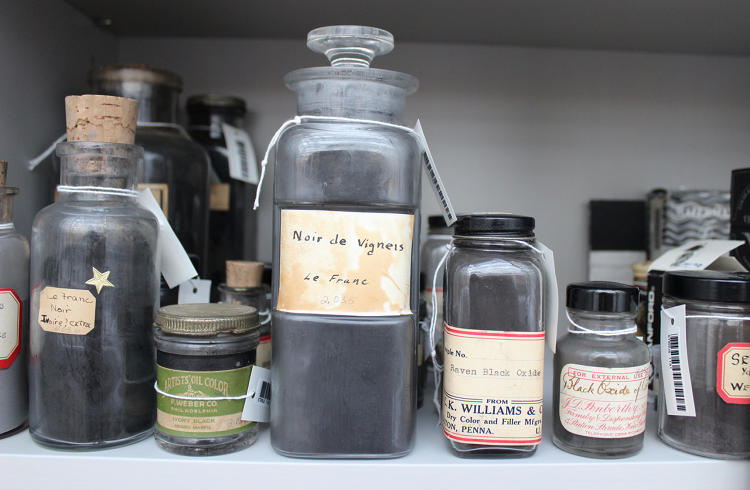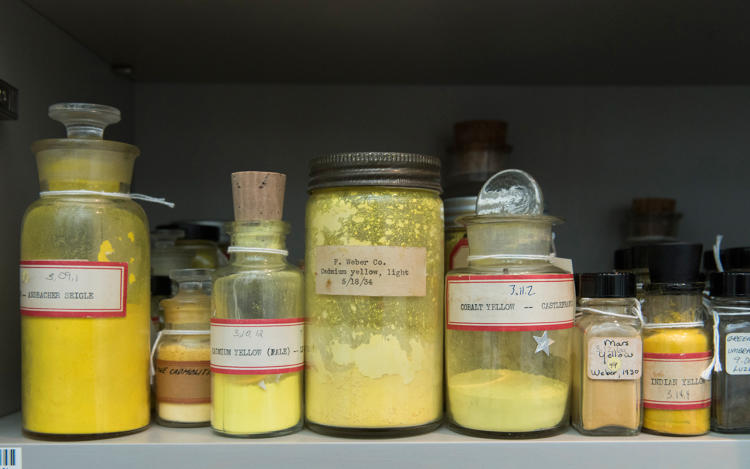The Harvard Library That Protects the sector’s Rarest colours
today, each shade imaginable is at your fingertips. which you can peruse paint swatches at hardware outlets, flip via Pantone books, and fuss with the colour finder that includes most pc applications, unless achieving the hue of your heart’s desire. but rewind to a couple centuries ago and finding that one specific coloration might have intended trekking to a single mineral deposit in remote Afghanistan—as used to be the case with lapis lazuli, a rock prized for its good blue hue, which made it extra precious than gold in medieval times.

The historical past of pigments goes again to prehistoric instances, but so much of what we learn about how they relate to the art world comes from Edward Forbes, a historian and director of the Fogg artwork Museum at Harvard college from 1909 to 1944. thought to be the father of artwork conservation in the us, Forbes traveled world wide collecting pigments as a way to authenticate classical Italian artwork. over time, the Forbes Pigment collection—as his collection got here to be recognized—grew to more than 2,500 totally different specimens, each with its own layered backstory on its starting place, production, and use.
these days, the gathering is used largely for scientific prognosis, providing usual pigments to compare to unknowns. Narayan Khandekar is the director of the Straus middle for Conservation and Technical research at the Harvard art Museums and the gathering’s custodian. For the remaining 10 years, Khandekar has rebuilt the collection to include up to date pigments to better analyze twentieth century and up to date art.
quite a bit has changed in the artwork world on account that painters worked with “colormen”—as tradesmen in dyes and pigments have been recognized—to obtain their medium. The commercialization of paints has transformed that process. “Artists nowadays will use anything to get the concept that’s of their head right into a physical form,” Khandekar says. “it can be items of plastic. it usually is cans of food. it could be the rest. we’d like so that you could establish plenty of different supplies which can be industrially produced in addition to things that are produced specifically for artists’ use.”

the best way he describes his work gaining knowledge of and cataloging pigments is comparable to detective work. “We use our instruments in the identical means that forensic scientists do,” Khandekar says. “We examine and to find out what we are able to about the key compounds on the way to inform us the fabric’s foundation.” however as a substitute of instruments such as DNA prognosis, he and his crew of conservation scientists use ways such as Raman spectroscopy, mass spectrometry, gas chromatography, and electron microscopy to map out definitely the right chemical composition of a pigment.

as an instance, their work used to be instrumental in proving that a Jackson Pollock painting “rediscovered” in 2007 was in truth a fake, after pigment prognosis printed that a selected crimson colour used to be manufactured twenty years after the artist’s death. the color, pink 254, used to be a by-made from a chemical response first documented in 1974; it’s also nicknamed
“Ferrari crimson.”
“every pigment has its personal story,” Khandekar says. With that in thoughts, we asked him to share the tales of 10 of the rarest and most attention-grabbing pigments within the Forbes collection.

artificial Ultramarine
“This was found out in 1826 as the result of a contest. In a technique it is like discovering the way to make gold as artists not had to purchase pure ultramarine at nice price.”
Mummy Brown
“folks would harvest mummies from Egypt after which extract the brown resin material that was once on the wrappings across the our bodies and switch that into a pigment. it can be an awfully atypical kind of pigment, I’ve got to say, nevertheless it was very talked-about within the 18th and nineteenth centuries.”
Brazilwood
“Brazilwood is any of several tropical timber of the senna genus. Its hard, crimson-shade wooden has had restricted use for violins, bows, veneer, and top quality furniture. The wood comprises the colorant brasilin, which gives a deep-red to brownish shade. Brazilwood dye has been used for textile and leather-based dyes, inks, paints, varnish tints, and wooden stains.”
Quercitron
“A yellow vegetable dye, quercitron is extracted from the black or dark brown bark of the black oak, Quercus velutina, that’s native to the eastern and Midwestern parts of the us.”
Annatto
“The lipstick plant—a small tree, Bixa orellana, native to crucial and South the usa—produces annatto, a pure orange dye. Seeds from the plant are contained in a pod surrounded with a brilliant purple pulp. presently, annatto is used to color butter, cheese, and cosmetics.”
Lapis Lazuli
“individuals would mine it in Afghanistan, ship it across Europe, and it was once dearer that gold so it might have its personal price range line on a commission.”
Dragon’s Blood
“It has a great identify, however it’s now not from dragons. [The bright red pigment] is from the rattan palm.”
Cochineal
“This purple dye comes from squashed beetles, and it’s used in cosmetics and meals.”

Cadmium Yellow
“Cadmium yellow used to be introduced in the mid 19th century. it can be a vivid yellow that many impressionists used. Cadmium is a heavy metallic, very poisonous. within the early 20th century, cadmium crimson was once introduced. You in finding these pigments used in industrial procedures. Up unless the Nineteen Seventies, Lego bricks had cadmium pigment in them.”
Emerald green
“that is constructed from copper acetoarsenite. We had a Van Gogh with a bright green history that was recognized as emerald inexperienced. Pigments used for artists’ functions can find their approach into use in other areas as well. Emerald green was used as an insecticide, and you frequently see it on older wooden that may be put into the bottom, like railroad ties.”
<img alt="
The supplies collection, together with the Forbes collection of pigments and the Gettens assortment of media and varnishes, on the Straus middle for Conservation and Technical research, Harvard artwork Museums
” src=”http://c.fastcompany.internet/multisite_files/fastcompany/imagecache/slideshow_large/slideshow/2016/03/3058058-slide-3-the-rarest-colours-in-the-harvard-pigment-library.jpg”>
<img alt="
Narayan Khandekar, senior conservation scientist and director of the Straus middle for Conservation and Technical research at the Harvard artwork Museums, with the cupboards containing the supplies collection
” src=”http://b.fastcompany.net/multisite_files/fastcompany/imagecache/slideshow_large/slideshow/2016/03/3058058-slide-2-the-rarest-colours-in-the-harvard-pigment-library.jpg”>
<img alt="
Vials of pigments in the Straus center’s materials collection
” src=”http://b.fastcompany.internet/multisite_files/fastcompany/imagecache/slideshow_large/slideshow/2016/03/3058058-slide-4-the-rarest-colours-in-the-harvard-pigment-library.jpg”>
<img alt="
The pigments in the Forbes collection come from all over the arena, and some are stored of their authentic subtle glass containers.
” src=”http://a.fastcompany.web/multisite_files/fastcompany/imagecache/slideshow_large/slideshow/2016/03/3058058-slide-5-the-rarest-colours-in-the-harvard-pigment-library.jpg”>
<img alt="
The Straus heart’s supplies collection includes an impressive array of pigments to aid research and conservation work.
” src=”http://d.fastcompany.web/multisite_files/fastcompany/imagecache/slideshow_large/slideshow/2016/03/3058058-slide-6-the-rarest-colours-in-the-harvard-pigment-library.jpg”>



quick company , read Full Story
(96)













